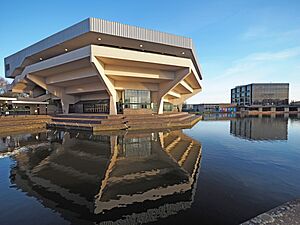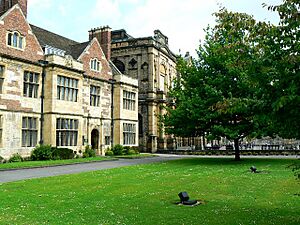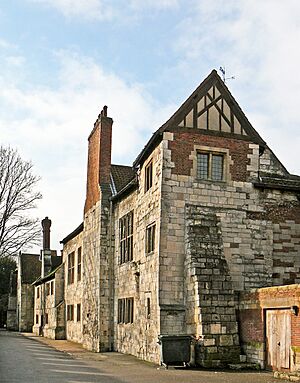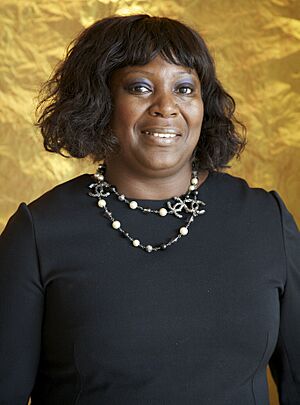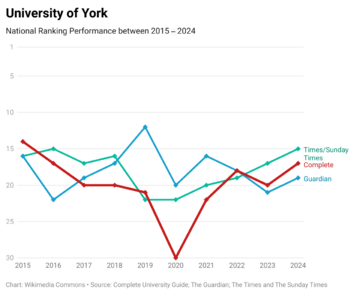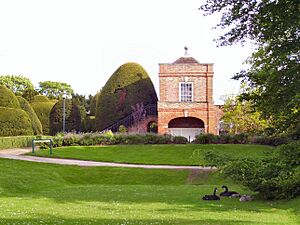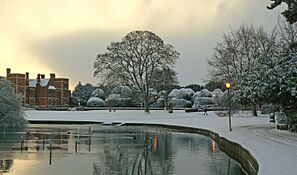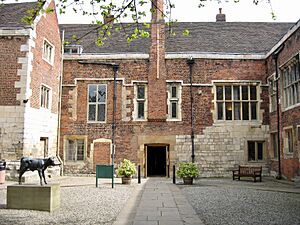University of York facts for kids
 |
|
| Latin: Universitas Eboracensis | |
| Motto | Latin: In limine sapientiae |
|---|---|
|
Motto in English
|
On the threshold of wisdom |
| Type | Public research university |
| Established | 1963 |
| Endowment | £7.85 million (2024) |
| Budget | £515.5 million (2023/24) |
| Chancellor | Heather Melville |
| Vice-Chancellor | Charlie Jeffery |
|
Academic staff
|
2,655 (2023/24) |
| Students | (2015/16) 20,230 FTE (2015/16) |
| Undergraduates | (2015/16) |
| Postgraduates | (2015/16) |
| Location |
Heslington, York
,
England
|
| Campus | Heslington West, Heslington East, and King's Manor |
| Colours | Dark blue and dark green |
| Affiliations |
|
 |
|
The University of York is a public university located in York, England. It's known for its unique "collegiate system," which means it's made up of several smaller colleges. The university opened in 1963 and has grown a lot since then. Today, it has over thirty different departments and centers where students can study many subjects.
The main campus is located southeast of the city of York and covers about 500 acres. This area includes Campus West, which has the York Science Park and the National Science Learning Centre. It's also known for its beautiful lakes and green spaces. In 2009, a second campus, Campus East, opened. It now has five colleges, three departments, sports facilities, and a business 'incubator' for new companies. The university also uses King's Manor in York city center.
York was one of the first "plate glass universities," a group of universities built in the 1960s. It has eleven colleges, with the newest, David Kato College, opening in 2022. The university is part of important research groups like the N8 Group and the Russell Group.
Contents
University History
Early Ideas for a University
People in York first asked for a university way back in 1617. More requests were made in 1641 and 1647, but they didn't happen because of the English Civil War. In the 1820s, there were more talks about starting a university in York, but then Durham University was founded in 1832 instead. In 1903, some groups suggested a "Victoria University of Yorkshire."
Oliver Sheldon, who worked for Rowntree's (a famous chocolate company) and helped start the York Civic Trust, was a big supporter of creating the university.
Starting the University
John Bowes Morrell was a key person in getting the university started. The University of York welcomed its first students in 1963, the same year Morrell passed away. It began with 216 undergraduate students, 14 postgraduate students, and 28 staff members.
The university first had six departments: Economics, Education, English, History, Mathematics, and Politics. At that time, it used three buildings: the historic King's Manor in the city center and Heslington Hall, a Tudor building on the edge of York. A year later, new buildings began to be built on the Heslington Campus, which is now the main part of the university.
Baron James of Rusholme, the university's first Vice-Chancellor (like a principal), wanted the university to have a college system. He also wanted it to focus on a limited number of subjects and teach mostly through small group discussions called "tutorials" and "seminars." Students were also involved in how the university was run, a model that many other universities later copied.
York's first two colleges, Derwent and Langwith, opened in 1965. These were the first places for students to live on campus. More colleges followed: Alcuin and Vanbrugh in 1967, Goodricke in 1968, and Wentworth College in 1972.
The university was known for its new ways of teaching. It was one of the first to offer "joint honors degrees," where students could study two different subjects together, like history and biology.
Growing the University
After 1972, no new colleges were built until 1990, when James College was founded. James College was first meant only for postgraduate students. However, the university quickly grew, almost doubling its student numbers from 4,300 to 8,500. So, in 1993, James College also started accepting undergraduate students.
More student numbers meant more housing was needed. This new housing was called 'Halifax Court'. In 2002, Halifax Court became a full college and was renamed Halifax College.
In 2003, the university planned to create a campus for 5,000 more students and add new subjects like law and dentistry. For a while, these plans were limited by building rules. The City of York rules said that only 20% of the land could be built on, and the original campus was already full.
In 2004, plans were finalized for a large extension, first called Heslington East, designed to be similar to the existing Heslington West campus. These are now known as Campus East and Campus West. The new campus was built on farmland between Grimston Bar and Heslington village. This land was specially removed from the "green belt" (protected land) for the university's expansion. After a long discussion and a public review in 2006, the government approved the plans in May 2007.
Construction began in 2008. The first buildings, including Goodricke College, opened in October 2009. Instead of building a new college, it was decided to move an existing one. Goodricke College moved to the new campus in 2009, and James College took over its old building on Campus West. The Duke of York officially opened Goodricke in April 2010. In 2012, Langwith College also moved to Campus East, and Derwent College took over its old buildings. In 2014, Campus East got its ninth college, Constantine College, named after the Roman emperor Constantine the Great.
In December 2019, work started on two more new colleges on Campus East. These colleges will have about 1,400 new student bedrooms and social areas. The university designed them to fit well with the beautiful landscape around the lake.
University Campuses
Campus West
Building on the Heslington Hall grounds began in 1964. The marshy land was drained, and the winding lake that is a key feature of the campus was created. The first buildings were designed by architects Sir Andrew Derbyshire and Sir Stirrat Johnson-Marshall. The buildings were put together using a system of pre-made parts, which is why York is called a "plate glass university." The buildings are connected by many covered walkways and bridges. Most of the arts departments are in the college buildings, while many science departments have their own separate buildings.
Central Hall
Central Hall is a famous building shaped like half an octagon. It's used for graduation ceremonies, exams, and performances. It's a historic building and has hosted famous musicians like the Wailers, George Melly, Soft Machine, Pink Floyd, and Paul McCartney. After a concert in 1985 where the stage cover was damaged, pop performances were less common, but the hall is now available for full bookings again. Classical concerts are often held in the music department's Sir Jack Lyons Concert Hall.
University Library
The University of York Library opened in 1965. The main library has three connected buildings on Campus West: the JB Morrell, the Raymond Burton, and the Fairhurst buildings. The Raymond Burton library was added in 2003 and holds humanities research materials and archives. In 2012, the library had a big renovation, adding the Fairhurst building, which now has most of the study spaces.
There's also a smaller library located in the King's Manor building.
Campus Grounds
The campus lake is the largest lake in Europe with a plastic bottom. It was designed to give the university a unique look and to help drain the flat land. The lake is home to many wild birds, including different types of geese, coots, moorhens, and ducks. There are also black swans and great crested grebes. Grey herons have been seen too. The southern part of the lake is a bird sanctuary.
The campus also has many rabbits. Campus West has both indoor and outdoor sports facilities, including an all-weather sports field and a cricket pitch. A large tent-like building is used for indoor sports, gymnastics, and dance.
Heslington Hall
Heslington Hall is a historic manor house built in 1568. During World War II, it was used by the Royal Air Force as a headquarters. After the war, the family who owned it didn't move back in. In 1955, it became a protected historic building. When the university was founded, it was turned into the university's main administrative office.
Science Park and Organizations
Next to the university on the York Science Park are several organizations. These include the Higher Education Academy, the Digital Preservation Coalition, and the York Neuroimaging Centre. Some parts of the School of Physics, Engineering and Technology are also located here. The Science Park is also home to the York Plasma Institute.
King's Manor
King's Manor is in York city center, about 2 miles (3 km) from the main campus. It used to be the Abbot's House of St Mary's Abbey and later became a government headquarters. For many years, it housed the Institute of Advanced Architectural Studies. Now, it's home to the Archaeology, Medieval Studies, and Eighteenth Century Studies departments. It also has a public restaurant and hosts art displays.
Near King's Manor is the Minster Library, which students and staff can use. It shares staff and cataloging with the main university library and has a large collection of old books from York Minster.
In 2024, the university announced it would stop using King's Manor for teaching and research because it was too expensive to maintain and had accessibility issues. The departments will move to the main Heslington campus.
Campus East
Campus East has modern facilities for several departments, including Law and the York Management School. In October 2010, the Department of Theatre, Film and Television and the Department of Computer Science moved into new buildings here.
Campus East also has the York Sports Village and a new £1.1 million Olympic-sized outdoor velodrome (a track for cycling), which is the only one in Yorkshire or the North East of England.
University Structure
Colleges
York is a "collegiate university," meaning it has eleven colleges. All colleges are equal and have their own rules. Each college is run by a College Council, which includes university staff and elected students. The daily operations are managed by university staff.
Most colleges have a "Junior Common Room" (JCR) for undergraduate students, run by elected student committees. Some colleges also have a "Graduate Common Room" for postgraduate students and a "Senior Common Room" for staff. The colleges are designed to have a mix of undergraduate, postgraduate, and staff members from different subjects. This helps create strong communities within the university.
In recent years, the university has built three new colleges on Campus East. The ninth college, Constantine, opened in 2014. The tenth, Anne Lister College, opened in 2021. The eleventh, David Kato College, opened in 2022.
| Name | Foundation | Named after |
|---|---|---|
| Derwent College | 1965 | River Derwent |
| Langwith College | 1965 | Langwith Common |
| Alcuin College | 1967 | Alcuin of York, scholar and advisor to Charlemagne |
| Vanbrugh College | 1967 | Sir John Vanbrugh, designer of Castle Howard |
| Goodricke College | 1968 | John Goodricke, astronomer |
| Wentworth College | 1972 | Thomas Wentworth, 1st Earl of Strafford |
| James College | 1990 | Lord James of Rusholme |
| Halifax College | 2002 | Edward Wood, 1st Earl of Halifax |
| Constantine College | 2014 | Emperor Constantine the Great |
| Anne Lister College | 2021 | Anne Lister, Yorkshire landowner and diarist |
| David Kato College | 2022 | David Kato, Ugandan human rights defender |
Academic Departments
The university has many research centers that bring together different subjects. These include the Borthwick Institute for Archives and centers for Medieval, Renaissance, Eighteenth-Century, and Modern Studies. The Department of Politics also has a Centre for Applied Human Rights.
Campus West is home to the National Science Learning Centre, which opened in 2006. It's a central point for a national network that aims to improve science teaching in schools.
- Department of Archaeology
- Department of Architecture and the Built Environment (opening September 2025)
- Department of Biology
- Department of Chemistry
- Department of Computer Science
- Department of Economics and Related Studies
- Department of Education
- School of Physics, Engineering and Technology
- Department of English and Related Literature
- Department of Environment and Geography
- Centre for Health Economics
- Department of Health Sciences
- Department of History
- Department of History of Art
- Department of Language and Linguistic Science
- York Law School
- School for Business and Society
- Department of Mathematics
- Hull York Medical School
- School of Arts and Creative Technologies
- School of Natural Sciences
- Department of Philosophy
- School of Philosophy, Politics and Economics
- Department of Politics and International Relations
- Department of Psychology
- Institute of Railway Studies
- Department of Sociology
University Leadership
Chancellors of the University
- George Lascelles, 7th Earl of Harewood (1962–1967)
- Kenneth Clark, Baron Clark (1967–1978)
- Michael Swann, Baron Swann (1979–1990)
- Dame Janet Baker (1991–2004)
- Greg Dyke (2004–2015)
- Sir Malcolm Grant (2015–2022)
- Dr Heather Melville, OBE (2022–present)
Vice-Chancellors of the University
- Eric James, Baron James of Rusholme (1962–1973)
- Morris Carstairs (1973–1978)
- Berrick Saul (1979–1993)
- Ron Cooke (1993–2002)
- Brian Cantor (2002–2013)
- Jane Grenville, acting (2013)
- Koen Lamberts (2014–2018)
- Saul Tendler, acting (2018–2019)
- Charlie Jeffery (2019–present)
University of York Music Press
The University of York Music Press (UYMP) was started in 1995. It publishes music by many composers, with over one thousand projects published so far.
University Reputation
Rankings and Awards
| National rankings | |
|---|---|
| Complete (2021) | 12 |
| Guardian (2021) | 25 |
| Times / Sunday Times (2021) | 17= |
| Global rankings | |
| ARWU (2020) | 301–400 |
| QS (2021) |
169 |
| THE (2021) | 146= |
| British Government assessment | |
| Teaching Excellence Framework | Gold |
The University of York is highly rated in many university rankings. QS placed York at 167th globally in 2024 and 184th in 2025. It also ranked 29th globally in the QS Sustainability Rankings for 2024. In the UK, all three major national rankings place York in the top 21.
In a 10-year average ranking (1998–2007) by The Sunday Times, York was ranked 6th overall in the UK. In 2000, the Sutton Trust also named York as a leading university, placing it 6th.
On November 25, 2010, York was named "University of the Year" at the Times Higher Education Awards. Judges praised it for being excellent academically while also being open to students from all backgrounds. In 2014, York was named the eighth best university in the world that was under 50 years old, and the best in the UK in that category.
Admissions Information
The University of York is a popular choice for students. For the 2022/23 school year, the average student entering York achieved 158 points on the UCAS tariff, which is a high score. The university offers admission to about 78.5% of its applicants. There are around 6.2 applications for every undergraduate spot. About 93.2% of students complete their degrees, and around 80% graduate with top honors (a First or 2:1 degree).
About 17.9% of York's undergraduate students come from private schools. In the 2016–17 school year, about 80% of students were from the UK, 5% from the EU, and 16% from outside the EU. More women attend the university than men, with a ratio of 56% female to 44% male. A large number of international students, 56.2%, come from China.
Student Life
Student Representation
The University of York Students' Union (YorkSU) represents all students at the university. In 2024, it merged with the postgraduate student union. YorkSU runs several venues, including The Courtyard.
Each college also has its own student committee that organizes events and provides support for students.
Students can join many different clubs and societies. There are political societies that discuss current events and organize debates. There are also groups that campaign on environmental and ethical issues.
For LGBT students, there are several organizations. The York SU LGBTQ+ Network supports LGBTQ+ students by campaigning for their rights, offering help, and holding events like cabaret nights. YorQueer also organizes social events. In November 2024, these two groups officially merged.
Student Union Venues
The university's Students' Union runs several bars and venues on both campuses, including The Courtyard, The Kitchen, The Glasshouse, The Lounge, and Vanbrugh Arms. D-Bar in Derwent College also reopened in 2022 after being temporarily closed.
In 2020, a new venue called The Forest was opened for various events. In 2021, The Lakeside Tap opened but closed the next year.
Student Media
York Student Television (YSTV) started in 1967 and is England's oldest student television station. It has won awards for being the best student television station.
University Radio York (URY) is the oldest independent student radio station in the UK and won the Best Station Award in 2020.
Nouse, a student newspaper, was founded in 1964 and has won many awards. Its rival newspaper, Vision, has also won many awards, including Guardian Student Newspaper of the Year multiple times.
The Lemon Press, York's satire magazine, started in 2009 and won an award in 2010. The Yorker is an online publication started by students in 2007.
York Student Cinema (YSC) has been showing films since the late 1960s. They use professional projectors and a large screen. They have won several awards for being a great film society.
In 2019, the History of Art department started publishing Aspectus, a research journal edited by postgraduate students.
Sports and Activities
The university's sports teams play in black and gold. York is a member of British Universities and Colleges Sport (BUCS) and has 65 teams.
Every summer, the university competes in the Roses Tournament, a sports competition against Lancaster University. It's the largest inter-university tournament in Europe, with many different sports. The location changes each year between York and Lancaster.
A new tournament called "College Varsity" started in 2014, where colleges from the University of York compete against colleges from Durham University.
Arts and Culture
The University of York Music Society and the University of York Drama Society are two of the biggest student groups on campus. They have performances and concerts every week during term time. The Central Hall Musical Society also puts on shows.
Other performing arts groups include the Gilbert and Sullivan Society, PantSoc (who stage student-written pantomimes), and York ComedySoc. ComedySoc is very active, putting on a show every week and offering workshops in stand-up, improv, and sketch comedy. They also send two shows to the Edinburgh Fringe festival each year.
Long Boi
Long Boi was a tall duck, about 70 cm (27 inches) high, who lived near Derwent College. He became an unofficial mascot for the university. In 2022, students campaigned for a life-sized statue of Long Boi because he was so important to student life.
In spring 2023, after not being seen for several months, the university announced that Long Boi was likely gone. A fundraising campaign collected enough money to create a life-size bronze statue of him. The statue was officially revealed by BBC Radio Presenter Greg James in The University of York's Central Hall on September 26, 2024. However, on November 14, 2024, the statue was damaged and later removed.
Famous People from York University

Many people who studied at the University of York have become famous in different fields.
In politics, there are many former students who became Members of the United Kingdom Parliament, members of the House of Lords, and even ministers in other governments around the world. For example, Aníbal Cavaco Silva, a former President and Prime Minister of Portugal, earned his doctorate in economics at York. Colville Young, the former Governor-General of Belize, has a doctorate in linguistics from York.
The university has also produced notable people in arts and culture. The author Anthony Horowitz studied English literature and art history at York. Greg Dyke, who used to lead the Football Association, also studied politics at York and later became the university's Chancellor. Writer and critic Victor Lewis-Smith studied music. Sir Michael Dixon, the current Director of the Natural History Museum, has a PhD in zoology from York. Youtuber Tom Scott graduated with a degree in linguistics. Businesswoman and TV star Sara Davies also studied business at York.
More recently, with the growth of technology studies, York has produced important computer scientists. These include Gavin Wood, who helped create Ethereum, and computer scientist Chris Lilley.
Famous teachers and researchers at the University of York have included literary teacher F. R. Leavis and anti-apartheid activist Adrian Leftwich.
Images for kids
See also
 In Spanish: Universidad de York para niños
In Spanish: Universidad de York para niños


